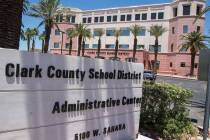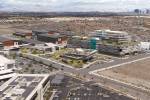UNLV revises tax initiative analysis
A UNLV research center on Tuesday issued a “more realistic” analysis of the impact of a proposed 2 percent state margins tax on business but still concluded it could create thousands of new jobs.
The original July 31 study by the Center for Business and Economic Research was criticized for concluding jobs would be gained — instead of lost as all other studies have shown — if voters approve the tax on Nov. 4. Question 3 is known as the “Education Initiative” because the money is supposed to go to schools.
UNLV President Don Snyder last week distanced the university from the study after businesses and gaming leaders opposed to the tax said it was flawed. Snyder said the study “does not represent the position or views of the university.”
As a result, the center revised its study and analysis, which had been commissioned by the Education Initiative PAC, which supports the margins tax backed by the Nevada State Education Association teachers union.
Stephen Brown, a UNLV professor and center director, said study authors felt no pressure to change the report.
“We listened to our critics,” Brown said in an interview, adding that while his colleagues in the economic department criticized the study, he never heard from Snyder. “I certainly didn’t feel stifled personally.”
In one revision, the center adopted an RGC Economics estimate that the proposed margins tax would collect about $795.3 million, up from $750 million it first calculated. The tax would apply to businesses in Nevada making at least $1 million in annual revenue with certain deductions, whether or not they are profitable.
The center also estimates net employment gains of 3,950 jobs in 2016 and 1,680 in 2017 from new teacher hires. Analysts for a broad range of private companies expect a net loss of thousands of jobs.
The updated scenario presumes the new revenue would go not only to hire new teachers but also for increasing salaries for existing teachers and increasing capital spending. Its previous study assumed all new revenue would go to hiring new teachers, resulting in net job gains of 12,990 in 2016 and 10,400 in 2017.
Overall, the revised study with the new scenario reduced its job gain estimates from a net total of 23,390 new jobs in 2016-17 to a net total uptick of 5,630 jobs — or about four times less.
Brown said that if all new revenue went to hire teachers, Clark County alone would have to boost its teaching staff by 65 percent and there wouldn’t be enough classrooms. The district now has 18,000 teachers.
“It wasn’t realistic,” Brown said, adding that schools might decide to shift money to address other needs, too.
As for the economic impact on Nevada’s gross domestic product, under the revised study it would be “a wash,” neither adding or subtracting much from the current annual GDP.
“We consider these smaller estimates to be more realistic,” the updated study said.
In the first study, estimated GDP losses were $550 million in 2016 and $820 million in 2017, if the margins tax passes.
Private industry would take a beating no matter what, with job losses of 5,840 in 2016 and 8,210 in 2017, the original study said. Despite that dismal prediction, the estimated increase in public sector or teacher jobs was expected to result in the net gain of 12,900 in 2016 and 10,400 in 2017.
The center’s study is generally positive about the impact of the margins tax but concludes that such a levy on gross revenues might not be as wise as approving a corporate income tax — something Nevada doesn’t have.
“The proposed margin tax could prove more costly to Nevada economic activity than a corporate income tax,” the study said.
All other studies, including one released in July by the conservative Nevada Policy Research Institute, predict net job losses in the thousands if the proposed margins tax passes. GOP Gov. Brian Sandoval has said it could devastate small businesses and hurt Nevada’s efforts to lure new companies here.
The NPRI study estimates 3,610 private jobs would be lost in 2015 if the margins tax goes into effect, raising an estimated $862.5 million. It also would lead to 1,970 new public jobs, including for teachers, for a net loss of 1,640 jobs.
The study also said imposing a margins tax would reduce Nevadans’ annual disposable income by $240 million and cut investment in the state by $7.1 million annually due to the ripple effects of a new business tax.
Contact Laura Myers at lmyers@reviewjournal.com or 702-387-2919. Find her on Twitter: @lmyerslvrj.




























